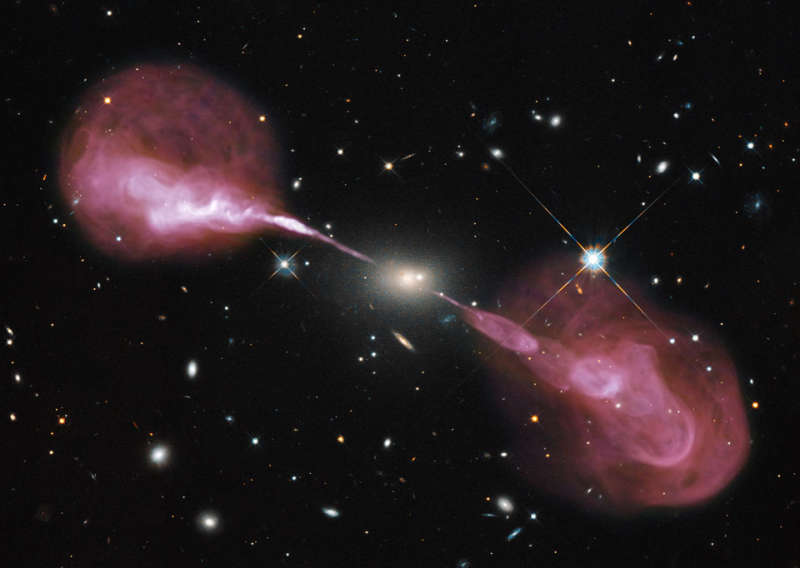Credit & Copyright: NASA,
ESA,
S. Baum &
C. O'Dea
(RIT),
R. Perley and
W. Cotton
(NRAO/AUI/NSF),
and the Hubble Heritage Team (STScI/AURA)
Explanation:
Why does this galaxy emit such spectacular jets?
No one is sure, but it is likely related to an active supermassive black hole at
its center.
The galaxy at the
image center,
Hercules A, appears to be a relatively normal
elliptical galaxy in
visible light.
When imaged in
radio waves,
however, tremendous
plasma
jets over one million light years long appear.
Detailed analyses indicate that the central galaxy, also known as
3C 348,
is actually over 1,000 times more massive than our Milky Way Galaxy,
and the central black hole is nearly 1,000 times more massive than the
black hole at our
Milky Way's center.
Pictured
above
is a visible light image obtained by the Earth-orbiting
Hubble Space
Telescope
superposed with a radio image taken by the recently upgraded
Very Large Array (VLA) of radio telescopes
in
New Mexico,
USA.
The physics that creates
the jets remains a topic of
research with a likely energy source being infalling matter
swirling toward the central
black
hole.
and the Hubble Heritage Team (STScI/AURA)
Follow APOD on:
Facebook
(Daily)
(Sky)
(Spanish)
or Google Plus
(Daily)
(River)
1999 2000 2001 2002 2003 2004 2005 2006 2007 2008 2009 2010 2011 2012 2013 2014 2015 2016 2017 2018 2019 2020 2021 2022 2023 2024 2025 |
Yanvar' Fevral' Mart Aprel' Mai Iyun' Iyul' Avgust Sentyabr' Oktyabr' Noyabr' Dekabr' |
NASA Web Site Statements, Warnings, and Disclaimers
NASA Official: Jay Norris. Specific rights apply.
A service of: LHEA at NASA / GSFC
& Michigan Tech. U.
|
Publikacii s klyuchevymi slovami:
active galaxy - radio galaxy - radio jets - aktivnaya galaktika - vybros - dzhet
Publikacii so slovami: active galaxy - radio galaxy - radio jets - aktivnaya galaktika - vybros - dzhet | |
Sm. takzhe:
Vse publikacii na tu zhe temu >> | |
